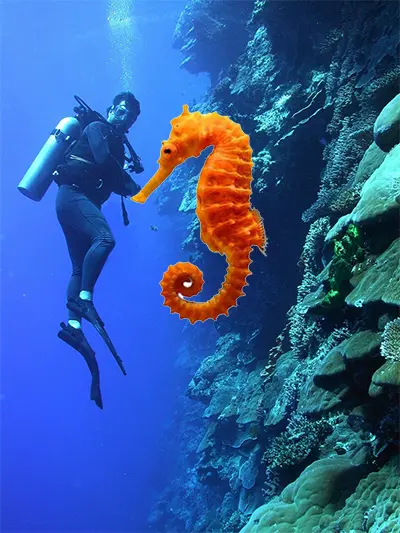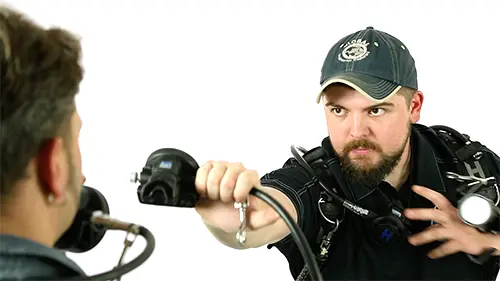GUE FUNDAMENTALS
WHY SHOULD YOU ATTEND A GUE FUNDIES CLASS
Most recreational scuba diving courses are typically completed over just 2 or 3 days, with the Open Water Diver course focusing primarily on the essential skills required by each agency. However, these courses often leave little time to delve into the finer aspects of diving, such as effectively using your BCD, mastering various propulsion techniques, and maintaining proper trim.
This is where a specialized course like the GUE Fundamentals (GUE Fundies) offers significant advantages. In this course, you’ll gain a deeper understanding of:
- Diving with a backplate BCD system and its benefits.
- Mastering different propulsion techniques using proper rigid fins.
- Achieving proper weighting and understanding the correct placement of weights.
- The critical role of standardization in diving.
- Developing situational awareness and the importance of team diving.
- Conducting a more thorough and detailed BWRAF (Begin With Review And Friend) check.
These elements contribute to a more comprehensive and effective approach to diving, enhancing both safety and enjoyment.
CURRENT PROBLEM
RECREATIONAL DIVING COURSE

Most recreational scuba diver courses are often conducted in groups of 4 to 8 divers, leaving little time to focus on proper body positioning or finning techniques. Given the short time frame, it’s also challenging for instructors to address the buoyancy issues of every diver in a basic Open Water Diver Course.
Neutral buoyancy and being in trim are two essential concepts. In simple terms, neutral buoyancy means divers can maintain their depth using a combination of breathing techniques and the right amount of air in their BCD, without significant changes in depth, avoiding unintentional ascents or descents. Many divers are content with “seahorse diving,” where they move from point A to B, observing marine life and taking selfies, often without considering their positioning in the water.
For those who are only exposed to this style of diving, it becomes the norm. It’s not until they encounter divers who demonstrate precise trimming and effective propulsion techniques that they realize there’s another level to diving.
Many divers may not see the need for precise trimming and buoyancy control, remaining content with their current skills. However, the GUE Fundamentals (GUE Fundies) course is designed for those who want to elevate their diving abilities. It appeals to divers who are committed to becoming better, willing to invest time and money into developing their skills. These divers understand that scuba diving isn’t just a hobby; it’s a sport that requires muscle memory, dedication, and a focus on safety to truly excel.
A RIGHT SOLUTION
GUE FUNDAMENTALS IN ACTION

A significant portion of the success of the GUE Fundamentals Course lies in the expertise of the GUE Instructor and embrassing a comprehensive and wholistic system. This system integrates detailed classroom presentations, land drills to build muscle memory, video debriefings of in-water sessions, and the use of the right equipment.
This wholistic approach is one of the most effective methods for diver training, enabling both new and experienced divers to improve their skills by applying GUE’s teaching philosophy and multisensory learning techniques.
Here’s how the GUE fundamental course is being structured to ensures success:
-
-
- Classroom Presentation: The course begins with in-depth classroom sessions where key concepts and techniques are thoroughly explained. This foundational knowledge is crucial for understanding the principles behind each skill.
- Dry Runs and Land Drills: Before entering the water, divers practice skills on land through dry runs and drills. These exercises help divers understand the mechanics of each technique and begin developing the muscle memory needed for in-water execution.
- In-Water Presentation and Practice: After land drills, divers take what they’ve learned into the water. The instructor provides in-water demonstrations and guidance, allowing divers to apply the skills in a real-world setting.
- Video Debriefing: Each in-water session is recorded, and the footage is reviewed during video debriefings. This step is critical, as it allows divers to see themselves in action, understand their mistakes, and make necessary adjustments. The visual feedback is invaluable for reinforcing proper techniques and correcting errors.
-
This sequence of training, repeated over the course of four days, is designed to transform a “seahorse diver”—who might rely on inefficient movements and poor body positioning—into a diver capable of executing precise propulsion techniques and maintaining proper trim. By the end of the course, divers are not only more skilled but also more confident in their abilities, with a deeper understanding of the principles that lead to safer and more effective diving
